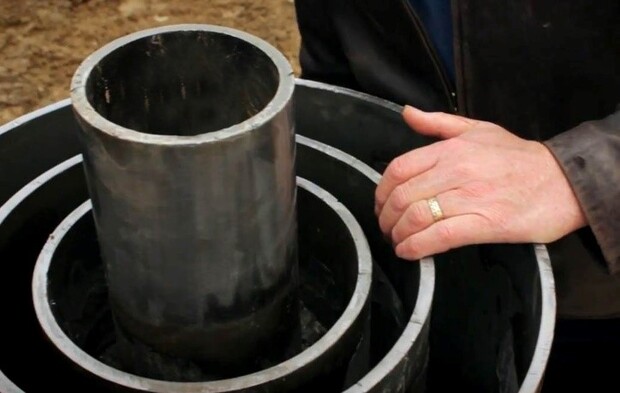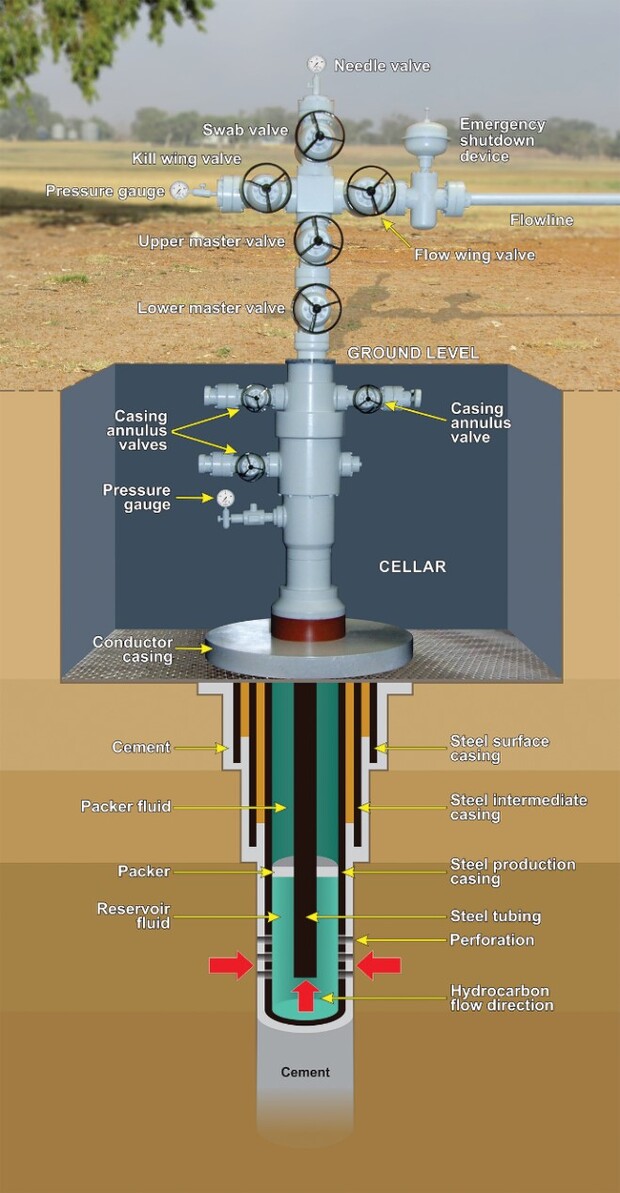Well design and integrity for hydraulic fracturing
Well integrity refers to preventing or reducing the risk of uncontrolled release of fluids (petroleum liquids, gases or water) from a petroleum well into the surrounding environment. Well design is critical to maintaining well integrity.

How is a well designed to maintain integrity?
Every well is designed, constructed, operated, maintained and finally decommissioned with specific well integrity considerations in mind.
Fluids, such as oil, gas and water that are present in subsurface rock formations are under pressure from the layers of rock above them. When a well is drilled, this formation pressure is exerted on the wellbore, potentially resulting in the flow of these fluids into the well. To counteract this pressure, the well is constructed using fixed equipment that includes a wellhead, casing, liners, cement, tubing, valves and packers, as well as specialised drilling fluids. These components provide integrity by forming a series of pressure-rated barriers that isolate rock formations and aquifers from the wellbore. The barriers prevent fluids and materials from entering or exiting the well in an uncontrolled manner, thus maintaining environmental and safety control.
Pressure control before the barriers are in place is provided primarily by the hydrostatic pressure exerted by the drilling fluid, with secondary control provided by a blowout preventer (BOP).
The objectives of well design are to:

- ensure that pressure exerted by fluids in subsurface rock formations (formation pressure) is safely controlled at all times;
- prevent flow of fluids between different rock formations by isolating the formations from each other;
- prevent the uncontrolled flow of fluids from the well; and
- prevent any fluids from the external environment (in the subsurface rock or on the surface) from entering the wellbore.
Well design always adheres to the principle of maintaining at least two barriers (a primary and a secondary barrier) in place across any potential leak path. This means that if a primary barrier is breached, the secondary barrier will prevent leakage until the primary barrier is reinstated.
How is a well constructed?
A petroleum well is drilled as a series of hole sections, with the largest diameter section drilled first. Each hole section is lined with pressure-rated steel casing, which is cemented in place in the well to isolate the well from the surrounding rock, before the next hole section is drilled.
A wellhead is installed on the surface casing. A BOP is installed on the wellhead and pressure tested after the surface casing is cemented in place. The casing is cemented by pumping a cement slurry down the inside of the casing. Drilling mud is then pumped down the casing to chase the cement slurry out of the bottom of the casing. The cement is pushed up the outside of the casing to fill the annulus between the casing and the rock formations. Cementing back to surface means that enough cement is pumped to completely fill that annulus.
The top hole section (first section of a well drilled) may reach depths between 500m and 1,200m below surface, depending on the location of any shallow aquifers. The surface casing in this section protects shallow aquifers from any fluid flow within the well.
Subsequent hole sections are lined with casing and cemented in place as the well is deepened. Each casing extends to, or is “set” and cemented at a different depth within the well, with surface casing being the shallowest and production casing being the deepest. The casings are also connected at the wellhead, itself a pressure-rated component capable of withstanding the maximum anticipated pressure in the well.
A Christmas tree is installed onto the wellhead at the surface once drilling is completed, replacing the BOP. The Christmas tree is connected to a production facility via a flowline. All components are pressure-tested and verified to act as barriers to leakage.
In a production well, small perforations are created through the steel production casing and cement to create a path for hydrocarbons to flow into the well. Perforations are made only next to the hydrocarbon-bearing rock, which generally lies many kilometres below the surface. Production tubing is installed into the well to provide a conduit through which hydrocarbons can be recovered to surface.
Cement is a critical component of well construction and therefore cementing is a fully designed and engineered process. Cementing procedures must meet international standards.
Well design must meet international standards. The recommended onshore petroleum casing design includes the following:
- Conductor casing: used to prevent loose surface sediment from collapsing into the well and to protect shallow surface aquifers. This casing is about 50m deep and is cemented to the surface.
- Surface casing: used to protect groundwater, it is set below the potable aquifers, usually between 500m and 1,200m below the surface, and is cemented to the surface.
- Intermediate casing: usually used for deeper wells to reduce the amount of open hole to manage when drilling to the target formation.
- Production casing or liner: the final casing set for a production well. The cement outside this casing will isolate the hydrocarbon zone from other subsurface rock formations. If it is casing, it will run from the well’s total depth to the surface, while a liner will be run from the well’s total depth to an appropriate overlap inside the previous casing.
- Production tubing: commonly run inside the intermediate casing to act as a conduit through which oil or gas is produced.
How is the integrity of the well tested and monitored?
A number of safeguards and measures are put in place when drilling and completing a well to ensure there is no uncontrolled leakage. For example, well integrity may be confirmed by ensuring that the cement has sealed and bonded correctly. This is done through a process called cement bond logging, which uses a tool to log the cement bond between the casing/cement and the cement/rock formation.
The components used in the construction of a well are pressure tested in excess of the maximum expected underground pressures, to ensure well integrity during the entire production life of the well.
Registered title holders of a petroleum title must conduct monitoring of real-time pressures and drilling fluids during drilling operations and report these to the Department of Mines, Industry Regulation and Safety (DMIRS) daily. DMIRS engineers review these reports, and conduct site audits and inspections to ensure operations are undertaken in a safe manner, and in accordance with the approved plans and good oilfield practice. Pressures are monitored continuously during production operations.
What processes are in place to regulate well integrity?
Registered title holders must submit an application to DMIRS before any petroleum well is drilled. The application must include the Well Management Plan (WMP), which details the geological prognosis and how the company will drill the well, the Environment Plan (EP) and the Safety Management System (SMS). The basis of design is assessed and approved by DMIRS before any activities can commence.
Registered title holders must also submit a revised WMP, EP or SMS when they conduct any additional activities during the life of the well, and these must be approved by DMIRS before operations can commence.
Oil and gas may be produced from a well for several decades. During this time, registered title holders are required to maintain the well. Regular well integrity checks are required, with DMIRS monitoring these activities and receiving their reported results. Any anomalies must be investigated and remediated.
What happens after the hydrocarbons have been extracted?
DMIRS requires the registered title holder to submit a revised WMP, EP and SMS covering the decommissioning of a well that has finished producing. Decommissioning a well means isolating hydrocarbon-bearing formations from the surface, which is accomplished by setting a series of mechanical and cement plugs as barriers at key points in the well. The revised WMP details the procedures to be used and the cement and mechanical plugs that are to be installed. All surface equipment, including the wellhead, must be removed from the site.
The site is then required to be remediated in order to return it to its original state. As with all petroleum activities, approval is given if it is demonstrated that the program is in accordance with good oilfield practice, standards and codes.
Terms used
annulus: the space between two concentric objects, such as between the wellbore and the casing or between the casing and the tubing, where fluid can flow.
barrier: one or several components preventing fluids from flowing unintentionally from the formation into the wellbore, into another formation or to the external environment.
blowout preventer (BOP): a device that can be used to quickly seal the top of a well in the event of a well control event. It usually comprises several sets of valves (called rams) installed on top of the wellhead which, when closed, will seal around drill pipe, preventing uncontrolled flow of formation fluids from a well. Since BOPs are critically important to the safety of the crew, the rig and the wellbore itself, BOPs are inspected, tested and refurbished at regular intervals determined by a combination of risk assessment, local practice, well type and legal requirements.
casing: metal pipe placed in a well to prevent the walls of the hole from collapsing and to prevent movement of fluids across subterranean geological formations. It also maintains control of fluid and pressure during drilling.
cement: the material used to permanently seal annular spaces between casing and borehole walls. Cement is also used to seal formations to prevent loss of drilling fluid.
cement bond logging: an acoustic device inside casings detects the presence of cement, according to the absorption or reflection of transmitted sound signals. It is used to test if cement is adhering effectively to both sides of the annulus between casings or between the outer casing and sides of the rock.
decommission/decommissioning: an industry term for the process of preparing a well to be closed permanently, usually after either monitoring has determined that there is insufficient oil or gas potential to complete the well or after production operations have drained the reservoir.
flowline: a surface pipeline carrying oil, gas or water that connects the wellhead to a production facility.
integrity (of a well): the application of technical, operational and organisational solutions to reduce risk of uncontrolled release of formation fluids throughout the life cycle of a well (NORSOK Standard D-010).
liner: the innermost casing in which the productive zones of a well are completed. The liner does not extend to the surface, but overlaps the bottom of the previous casing.
packer: a device that can be run into a wellbore with a smaller initial outside diameter that then expands externally to seal the wellbore. In a well completion, it isolates the annulus from the production tubing, enabling controlled production, injection or treatment.
perforations: small holes pierced in the casing and cement in a well to allow formation fluids, including gas, to enter the well and, in turn, to allow fluids to be injected into a geological formation.
wellbore: the drilled hole, including the uncased portion of the well. Wellbore may refer to the inside diameter of the well, the rock face that bounds the drilled hole.
wellhead: the equipment at the surface above the well. Refer also to “Christmas tree? definition.
Definitions sourced from Schlumberger Oilfield Glossary and NORSOK Standard D-010.
